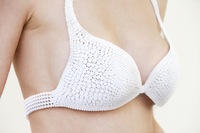 We were very excited to read about Shapeways latest creation: a 3D printed Bikini that you can actually purchase and wear! Up to now, most 3D printed fashions were wild, crazy and effectively impractical for common use. Typically you’d see 3D printed fashions in a museum or modern art event, but never in a place you could access for your own wearing pleasure. Until now.
We were very excited to read about Shapeways latest creation: a 3D printed Bikini that you can actually purchase and wear! Up to now, most 3D printed fashions were wild, crazy and effectively impractical for common use. Typically you’d see 3D printed fashions in a museum or modern art event, but never in a place you could access for your own wearing pleasure. Until now.Shapeways member Continuum has created at great effort a true 3D printable bikini set, the N12 (named after its material, Nylon 12). They’re using one of Shapeways’ unique materials, “White Strong and Flexible”, and were inspired by Shapeways’ experimental print of digital fabric. The N12 is composed (mainly) of tiny flat comfortable disks held together with very thin flexible connectors, and is composed of four parts: two straps and two cups.
Sounds good so far, but then the challenges mount: how do you create the correct sizing and shape? For something like a bikini, which by definition is pressed close to important body bits, it should fit absolutely correctly. Extensive experimentation and coding resulted in a way to generate the correct curves and sizes. The buyer is presented with a matrix of possible size combinations and she selects the appropriate one. It seems to work, although the prices are a bit highish: Halter USD$30, Strap USD$40, Right Cup USD$102.50, Left Cup USD$102.50, total USD$275.
But this pioneering effort illustrates a huge barrier to widespread 3D printed clothes: customizing sizes. If the notion of 3D printing a “perfectly matched” item is what 3D printing is all about, then 3D printed clothes had better do it. But to do so will require pretty sophisticated sizing algorithms by all clothing makers to adjust the associated 3D models. That’s a barrier.
Via Shapeways and Continuum Fashion (Hat tip to Kris)

